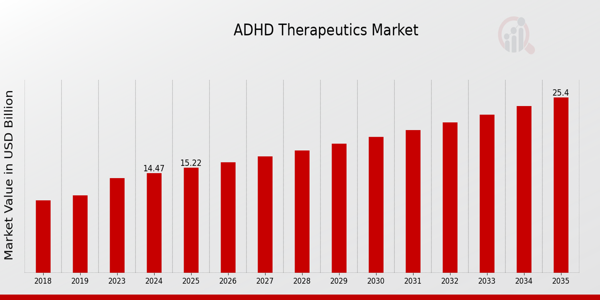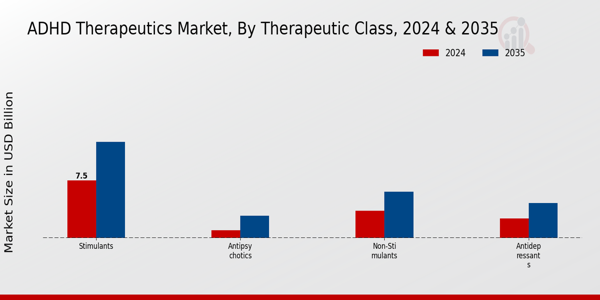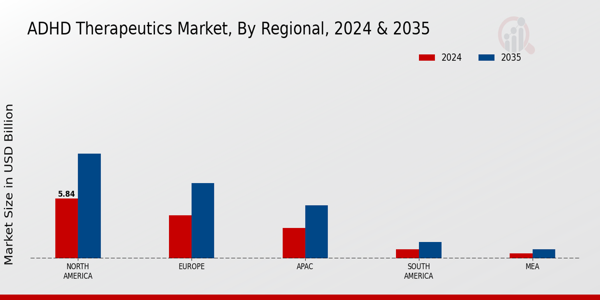ADHD Therapeutics Market Overview
As per MRFR analysis, the ADHD Therapeutics Market Size was estimated at 13.74 (USD Billion) in 2024.The ADHD Therapeutics Market Industry is expected to grow from 14.47(USD Billion) in 2025 to 25.4 (USD Billion) by 2035. The ADHD Therapeutics Market CAGR (growth rate) is expected to be around 5.25% during the forecast period (2025 - 2035).
Key ADHD Therapeutics Market Trends Highlighted
The Global ADHD Therapeutics Market is witnessing several significant trends influenced by various factors. One of the key market drivers is the increasing prevalence of ADHD diagnoses, especially in children and adolescents. As awareness grows around mental health issues, more individuals are being evaluated and receiving treatment. This has led to a higher demand for effective ADHD medications and therapies.
Furthermore, the move towards personalized medicine is gaining traction, with pharmaceuticals and therapeutic interventions being tailored to the specific needs of patients, enhancing treatment outcomes. Opportunities in the market remain vast as well.The rise in telehealth services and digital healthcare solutions has created new avenues for reaching patients, especially those in remote areas who may have limited access to traditional healthcare facilities.
There is also an opportunity to innovate in developing non-stimulant medications, as some patients experience side effects or prefer alternatives to standard therapies. The growth of educational programs and support services for families and educators represents another important opportunity to improve management strategies for ADHD. Recent trends also reflect a shift in the approach to ADHD treatment.
There is a notable increase in holistic approaches that incorporate behavioral therapies alongside medications, aiming to provide a comprehensive treatment plan.Additionally, ongoing research into the underlying causes of ADHD is driving the development of novel therapeutics that target specific biological pathways. As the regulatory landscape evolves to accommodate new treatments, the market is likely to see further expansion, allowing for improved management of ADHD globally.

Source: Primary Research, Secondary Research, MRFR Database and Analyst Review
ADHD Therapeutics Market Drivers
Increasing Awareness and Diagnosis of ADHD
The Global Attention Deficit Hyperactivity Disorder (ADHD) Therapeutics Market is significantly driven by the increasing awareness and diagnosis of ADHD among both healthcare professionals and the general public. In recent years, initiatives by organizations like the World Health Organization (WHO) have emphasized the importance of recognizing ADHD as a legitimate mental health condition. For instance, WHO reports indicate that the prevalence of ADHD in children ranges between 5% to 7%, equating to approximately 100 million children globally experiencing symptoms.
This heightened awareness has encouraged parents and educators to seek professional evaluations, contributing to an increase in diagnosed cases. Consequently, as more individuals are diagnosed, the demand for ADHD therapeutics is expected to grow significantly. Furthermore, the Global ADHD Therapeutics Market Industry will likely see advancements in treatment options, further propelled by the need for effective management of the disorder.
Innovation in Treatment Options
The Global ADHD Therapeutics Market is bolstered by rapid innovation in treatment options that cater to diverse patient needs. The introduction of novel medications and formulations, such as long-acting stimulants and non-stimulant alternatives, provides healthcare providers with a broader range of tools for effective treatment. Companies like Novartis and Johnson Johnson are continually investing in Research and Development to produce effective therapies designed to improve patient compliance.
For example, the development of once-daily dosing forms has been shown to enhance adherence among patients. With approximately 85% of ADHD patients being prescribed medication, the ongoing development of innovative treatments directly correlates with market growth, as patients and practitioners are more likely to explore and adopt these modern therapeutic options.
Increased Investment in Mental Health Initiatives
Globally, there has been a notable increase in public and private investment in mental health initiatives that specifically target ADHD. Government bodies and non-profit organizations are collaborating to improve mental health care infrastructure and provide resources for ADHD diagnosis and treatment. For instance, in recent initiatives, governments worldwide are allocating up to 10% of their healthcare budgets toward mental health, aiming to address the rising prevalence of conditions like ADHD.
This increase in funding facilitates better access to care, availability of therapies, and support programs, which are crucial for improving patient outcomes. As mental health becomes a priority on national health agendas, the Global ADHD Therapeutics Market Industry stands to benefit substantially from these investments, leading to enhanced growth opportunities.
ADHD Therapeutics Market Segment Insights
ADHD Therapeutics Market Therapeutic Class Insights
The Global ADHD Therapeutics Market is evolving significantly, with the Therapeutic Class segment playing a crucial role in shaping its landscape. By 2024, the overall market is valued at 14.47 USD Billion, indicating a robust interest in various treatment options for ADHD. Within this framework, stimulants dominate the market, holding a valuation of 7.5 USD Billion in 2024, projected to escalate to 12.5 USD Billion in 2035.
This segment is vital because stimulants have been shown to significantly improve attention and focus in ADHD patients, making them the preferred choice for many healthcare providers and patients.Following this is the Non-Stimulants category, which is expected to be valued at 3.5 USD Billion in 2024 and grow to 6.0 USD Billion by 2035, catering to individuals who may experience adverse effects with stimulant medications.
Antidepressants also hold a relevant space in the market, valued at 2.5 USD Billion in 2024, increasing to 4.5 USD Billion in 2035, as they can be beneficial for patients who experience comorbid conditions like anxiety, thus enhancing their overall treatment outcome. In contrast, antipsychotics represent the smallest segment, with a valuation of 0.97 USD Billion in 2024 projected to reach 2.9 USD Billion by 2035.Although this segment accounts for a minor share, it is crucial for patients exhibiting significant behavioral challenges as a result of ADHD.
The segmentation of the Global ADHD Therapeutics Market allows for a nuanced understanding of treatment approaches, with each class addressing unique patient needs and preferences. This diverse therapeutic offering is essential for optimizing treatment plans and managing the symptoms of ADHD effectively, thereby driving the overall growth of the market. As the awareness of ADHD continues to rise, along with advances in pharmacological research, the Global ADHD Therapeutics Market statistics suggest that each segment will increasingly contribute to market growth, tapping into various patient demographics and enhancing therapeutic possibilities.

Source: Primary Research, Secondary Research, MRFR Database and Analyst Review
ADHD Therapeutics Market Route of Administration Insights
The Global ADHD Therapeutics Market reflects a comprehensive approach to treatment, with the Route of Administration being a crucial segment in this landscape. Within this framework, various routes such as Oral, Injectable, and Transdermal play vital roles. Oral administration is often preferred due to its ease of use and widespread acceptance among patients, which positions it as a dominating method in everyday treatment scenarios.Injectable forms, while less common, offer benefits in terms of faster action and adherence, particularly in cases where monitoring is essential.
Transdermal delivery systems provide consistent medication levels, addressing challenges related to gastrointestinal absorption making them integral for specific patient populations. The Global ADHD Therapeutics Market segmentation reveals these varied administrative options are driving market growth, as they allow for tailored treatment approaches, catering to individual patient needs and preferences while addressing the ongoing demand for effective therapeutic solutions globally.
ADHD Therapeutics Market Age Group Insights
The Global ADHD Therapeutics Market is set to evolve significantly within the Age Group segment, reflecting the growing awareness and diagnosis of Attention Deficit Hyperactivity Disorder across varying ages. This segment encompasses Children, Adolescents, and Adults, each playing a pivotal role in driving the market forward.
Children represent a major demographic, as they often receive early diagnosis and treatment, which is crucial for long-term management.Adolescents face unique challenges, such as academic pressures and social dynamics, leading to increased therapeutic needs. The Adult segment is becoming increasingly significant as research underscores the persistence of ADHD symptoms into adulthood, prompting a surge in adult-focused therapy options.
The Global ADHD Therapeutics Market statistics reveal that as awareness intensifies and stigma diminishes, more individuals across these age groups seek treatment, facing challenges such as medication adherence and access to care. Moreover, opportunities abound in the development of tailored therapeutic options that cater specifically to the needs of these diverse age demographics, contributing to overall market growth and expansion.
ADHD Therapeutics Market Distribution Channel Insights
The market encompasses various channels including Retail Pharmacy, Hospital Pharmacy, and Online Pharmacy, each playing a significant role in meeting the diverse needs of consumers. Retail pharmacies serve as a primary point for medication access, while hospital pharmacies are crucial for providing specialized care within healthcare facilities.
Meanwhile, the rise of online pharmacies has transformed the way patients obtain their ADHD therapies, contributing to increasing convenience and access.This shift towards digital transactions reflects a broader trend in healthcare, where technology is enhancing patient engagement and medication adherence.
Additionally, the expanding prevalence of ADHD across the globe fuels demand across these distribution channels, creating an opportunity for stakeholders to innovate and adapt their approach to capture a larger share of the Global ADHD Therapeutics Market revenue. With ongoing developments in treatment options and increasing awareness, these distribution channels are positioned to capitalize on the market growth, driving forward the landscape of ADHD therapeutics.
ADHD Therapeutics Market Regional Insights
The Global ADHD Therapeutics Market exhibits substantial variation across its regional segmentation, highlighting distinctive trends and significant growth potential. In 2024, North America leads the market with a valuation of 5.84 USD Billion, projected to rise to 10.21 USD Billion by 2035, reflecting a majority holding that emphasizes the region's strong healthcare infrastructure and awareness of ADHD. Europe follows with a valuation of 4.23 USD Billion in 2024, increasing to 7.33 USD Billion by 2035, showcasing its commitment to mental health initiatives.
The APAC region, valued at 2.96 USD Billion in 2024, is expected to grow to 5.16 USD Billion by 2035, driven by increased diagnosis rates and government support for mental health. South America and the MEA regions present smaller market sizes, with valuations of 0.92 USD Billion and 0.52 USD Billion respectively in 2024, but they indicate growth opportunities due to rising awareness and evolving healthcare access. Overall, with the projected growth across these regions, the market dynamics of the Global ADHD Therapeutics Market reveal critical insights into demographic trends, healthcare policies, and increased patient treatment options.

Source: Primary Research, Secondary Research, MRFR Database and Analyst Review
ADHD Therapeutics Market Key Players and Competitive Insights
The Global ADHD Therapeutics Market is characterized by a variety of competitive dynamics, fueled by a growing awareness of attention-deficit/hyperactivity disorder and the increasing demand for effective treatment options. Companies in this sector are actively engaged in the development, production, and marketing of therapeutics aimed at mitigating the symptoms of ADHD. The market witnesses numerous players ranging from large multinational corporations to specialized biotech firms, each striving for innovation and a stronger foothold in various regions.
The competitive landscape is shaped by factors such as product efficacy, safety profiles, regulatory approvals, and marketing strategies, further complicated by the evolving spectrum of treatment paradigms and patient preferences. To thrive in this market, companies are emphasizing research and development capabilities, strategic collaborations, and comprehensive product portfolios to meet the growing needs of patients and healthcare providers.
Pfizer stands out in the Global ADHD Therapeutics Market with a robust presence that underscores its commitment to addressing the needs of those affected by ADHD. The company has established itself as a prominent player in this sector through its development of advanced therapeutic options. Pfizer's strengths lie in its extensive research and development network, which enables the company to innovate consistently and introduce new pharmacological solutions that cater to diverse patient populations.
With a strong global footprint, the company can leverage its established relationships with healthcare providers and regulatory authorities, ensuring a strategic advantage in the market. Its ability to quickly adapt to changing market dynamics while maintaining high-quality standards in its therapeutic offerings positions Pfizer favorably among its competitors.
Neos Therapeutics also holds a significant position in the Global ADHD Therapeutics Market, primarily recognized for its specialized focus on developing unique formulations that deliver effective ADHD treatment. The company distinguishes itself with its key products, which include innovative drug delivery systems targeting both children and adults diagnosed with ADHD. With a commitment to research and development, Neos Therapeutics continually enhances its product offerings, ensuring they meet high standards of efficacy and safety.
The company has established strategic partnerships to facilitate growth and innovation, enhancing its capabilities to bring novel solutions to the market. Mergers and acquisitions have also played a role in strengthening Neos Therapeutics' market presence, allowing it to expand its product portfolio and enhance its competitive edge. This strategic maneuvering, combined with its strong focus on patient-centric therapies, underscores Neos Therapeutics' role as a key player in the ADHD therapeutics arena globally.
Key Companies in the ADHD Therapeutics Market Include
- Pfizer
- Neos Therapeutics
- Krema
- Sandoz
- Amgen
- Supernus Pharmaceuticals
- Roche
- Eli Lilly
- Boehringer Ingelheim
- Otsuka Pharmaceutical
- Novartis
- Aptinyx
- Janssen Pharmaceuticals
- Teva Pharmaceutical
- Shire
ADHD Therapeutics Market Industry Developments
Recent developments in the Global ADHD Therapeutics Market have been shaped by ongoing advancements in treatment options and strategic movements by key players. Pfizer has made strides in optimizing its ADHD drug portfolio, while Neos Therapeutics is gaining attention for its innovative formulations. Companies like Supernus Pharmaceuticals and Amgen have also been active in Research and Development to improve existing treatments. Current affairs indicate a robust demand for effective ADHD therapies, given the growing prevalence of the condition globally.
In recent months, notable growth has been reported, particularly with Eli Lilly and Otsuka Pharmaceutical strengthening their market positions through new launches. Merger and acquisition activity remains significant, as exemplified by the acquisition of Shire by Takeda completed in January 2019, which has enhanced Takeda's standing in the ADHD space. Additionally, Novartis is exploring strategic partnerships to expand its ADHD therapeutics. Over the past two years, the market has seen a marked increase in collaboration among companies, leading to innovative product developments and regulatory approvals that continue to bolster the market value of ADHD therapeutics globally.
ADHD Therapeutics Market Segmentation Insights
ADHD Therapeutics Market Therapeutic Class Outlook
- Stimulants
- Non-Stimulants
- Antidepressants
- Antipsychotics
ADHD Therapeutics Market Route of Administration Outlook
- Oral
- Injectable
- Transdermal
ADHD Therapeutics Market Age Group Outlook
- Children
- Adolescents
- Adult
ADHD Therapeutics Market Distribution Channel Outlook
- Retail Pharmacy
- Hospital Pharmacy
- Online Pharmacy
ADHD Therapeutics Market Regional Outlook
- North America
- Europe
- South America
- Asia Pacific
- Middle East and Africa
| Report Attribute/Metric Source: |
Details |
| MARKET SIZE 2023 |
13.74(USD Billion) |
| MARKET SIZE 2024 |
14.47(USD Billion) |
| MARKET SIZE 2035 |
25.4(USD Billion) |
| COMPOUND ANNUAL GROWTH RATE (CAGR) |
5.25% (2025 - 2035) |
| REPORT COVERAGE |
Revenue Forecast, Competitive Landscape, Growth Factors, and Trends |
| BASE YEAR |
2024 |
| MARKET FORECAST PERIOD |
2025 - 2035 |
| HISTORICAL DATA |
2019 - 2024 |
| MARKET FORECAST UNITS |
USD Billion |
| KEY COMPANIES PROFILED |
Pfizer, Neos Therapeutics, Krema, Sandoz, Amgen, Supernus Pharmaceuticals, Roche, Eli Lilly, Boehringer Ingelheim, Otsuka Pharmaceutical, Novartis, Aptinyx, Janssen Pharmaceuticals, Teva Pharmaceutical, Shire |
| SEGMENTS COVERED |
Therapeutic Class, Route of Administration, Age Group, Distribution Channel, Regional |
| KEY MARKET OPPORTUNITIES |
Increased awareness and diagnosis, Rising prevalence in adults, Expansion of telehealth services, Development of non-stimulant therapies, Growth in personalized medicine approaches |
| KEY MARKET DYNAMICS |
Increasing prevalence of ADHD, Growing investment in research, Rising demand for personalized therapy, Enhanced awareness and diagnosis, Availability of novel treatment options |
| COUNTRIES COVERED |
North America, Europe, APAC, South America, MEA |
ADHD Therapeutics Market Highlights:
Frequently Asked Questions (FAQ) :
The Global ADHD Therapeutics Market is expected to be valued at 14.47 USD Billion in 2024.
The anticipated CAGR for the Global ADHD Therapeutics Market from 2025 to 2035 is 5.25%.
North America is projected to have the largest market share, valued at 5.84 USD Billion in 2024.
The ADHD Therapeutics Market in Europe is expected to grow to 7.33 USD Billion by 2035.
Major players in the market include Pfizer, Neos Therapeutics, Roche, Eli Lilly, and Novartis among others.
The market value for Stimulants in 2024 is projected to be 7.5 USD Billion.
The market value for Non-Stimulants is forecasted to reach 6.0 USD Billion by 2035.
The Antipsychotics segment is expected to grow from 0.97 USD Billion in 2024 to 2.9 USD Billion in 2035.
The APAC region is projected to have a market value of 5.16 USD Billion by 2035.
Growth drivers include increasing awareness, better diagnosis rates, and advancements in treatment options.


















